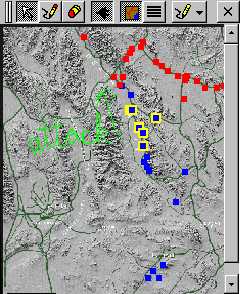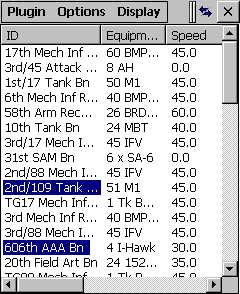
Uses of Hand-Helds in the
Command Post of the Future
Overview
As part of DARPA's Command Post of the Future program, the CMU group is working on components for a Command Post Information Environment that will provide new ways to collaborate with each other and to interact with supporting information assets and sources. The Pebbles part of this project is focusing on how handhelds can be used to access information and control devices. The results so far from the Pebbles part include:- Private Drill-Down of Public Information: Using visualizations of the CPOF maps, we have investigate the issues around how handhelds can be used for people in the command post to annotate, investigate and edit the shared maps and the information behind them. This research has integrated the software from MayaVis (visualizations), the CMU multimodal group (speech gestures, handwriting recognition, etc.), and Pebbles (handhelds) into one system.
- SlideShow Commander: Techniques for using handhelds to control PowerPoint presentations, including seeing a picture and the notes of the current slide, using the handheld to annotate slides, etc.
- RemoteCommander and Shortcutter: Techniques for using handhelds to control other applications running on the PC.
- Laser Pointers Interactions: An important part of the vision of the Command Post of the Future is the use of laser pointers. We have performed a variety of studies on how to make these more effective. One promising result shows that "snarfing" (copying) the area around the pointer dot to the handheld, performing the edits on the handheld, and then copying the results back works much better than trying to interact solely with the laser pointer.
- Collaboration and Turn-taking: When multiple people are sharing a single large display, it can be confusing and awkward to take turns controlling and annotating. In addition to the laser pointer work, we have also studied fundamental issues of "floor control" (who has control) as well as various ways that handhelds can help.
All of these are described in various publications listed below.
![]()
Pictures
When the main display shows a large map (Figure 1), the handheld can be used to annotate and investigate various scenarios (Figure 2) or to drill-down to investigate in detail in a table (Figure 3).
Figure 1: PC Screen

Figure 2: PDA Screen

Figure 3: PDA drill-down table

![]()
Funding
The part of the Pebbles project research on using handhelds in the Command Post of the Future is funded by:
-
DARPA, as part of the Command Post of the Future program.
This research was performed in connection with Contract number DAAD17-99-C-0061 with the U.S. Army Research Laboratory. The views and conclusions contained in this document are those of the authors and should not be interpreted as presenting the official policies or position, either expressed or implied, of the U.S. Army Research Laboratory or the U.S. Government unless so designated by other authorized documents. Citation of manufacturer's or trade names does not constitute an official endorsement or approval of the use thereof. The U.S. Government is authorized to reproduce and distribute reprints for Government purposes notwithstanding any copyright notation hereon.
![]()
Publications
All of the many Pebbles publications acknowledge the DARPA funding of this research. Of particular relevance to the CPOF program are the following publications:
-
Brad A. Myers, Herb Stiel, and Robert Gargiulo. "Collaboration Using Multiple PDAs Connected to a PC." Proceedings CSCW'98: ACM Conference on Computer-Supported Cooperative Work, November 14-18, 1998, Seattle, WA. pp. 285-294. Postscript or Adobe Acrobat (pdf)
- Brad A. Myers. "Using Hand-Held Devices and PCs Together," Communications of the ACM. Volume 44, Issue 11. November, 2001. pp. 34 - 41. Adobe Acrobat (pdf)
- Brad A. Myers, Rishi Bhatnagar, Jeffrey Nichols, Choon Hong Peck, Dave Kong, Robert Miller, and A. Chris Long. "Interacting At a Distance: Measuring the Performance of Laser Pointers and Other Devices." Proceedings CHI'2002: Human Factors in Computing Systems. Minneapolis, Minnesota, April 20-25, 2002. pp. 33-40. Adobe Acrobat (pdf)
- Brad A. Myers, Choon Hong Peck, Jeffrey Nichols, Dave Kong, and Robert Miller, "Interacting At a Distance Using Semantic Snarfing," ACM UbiComp'2001, Sept 30 - Oct 2, 2001, Atlanta, Georgia. pp. 305-314. Adobe Acrobat (pdf)
- Choon Hong Peck, "Useful Parameters for the Design of Laser Pointer Interaction Techniques." ACM CHI'2001 Student Posters. Seattle, WA. March 31-April 5, 2001. pp. 461-462. Adobe Acrobat (pdf)
- Brad A. Myers. "Using Multiple Devices Simultaneously for Display and Control." IEEE Personal Communications special issue on "Networking the Physical World." vol. 7, no. 5, Oct. 2000. pp. 62-65.
- Brad A. Myers, Robert C. Miller, Benjamin Bostwick, and Carl Evankovich, "Extending the Windows Desktop Interface With Connected Handheld Computers," 4th USENIX Windows Systems Symposium, August 3-4, 2000, Seattle, WA. pp. 79-88. postscript or Adobe Acrobat (pdf).
- Brad Myers, "The Pebbles Project: Using PCs and Hand-held Computers Together; Demonstration Extended Abstract." Adjunct Proceedings CHI'2000: Human Factors in Computing Systems. April 1-6, 2000. The Hague, The Netherlands. pp. 14-15.
- Karen Cross, Adrienne Warmack, and Brad Myers. "Lessons Learned: Using Contextual Inquiry Analysis to Improve PDA Control of Presentations". Submitted for Publication. postscript or pdf (Acrobat).
- Brad A. Myers. An Implementation Architecture to Support Single-Display Groupware. Carnegie Mellon University School of Computer Science Technical Report, no. CMU-CS-99-139 and Human Computer Interaction Institute Technical Report CMU-HCII-99-101. May, 1999. Available in postscript or pdf formats.
- Brad A. Myers, Jeff Nichols, Rob Miller. "User Interfaces that Span Hand-Held and Fixed Devices" Workshop on Distributed and Disappearing User Interfaces in Ubiquitous Computing at CHI'2001, Seattle, WA. Albrecht Schmidt, Peter Ljundgstrand, and Anind Dey, editors. University of Karlsruhe Faculty of Information Technical Report 2001-6. ISSN 1432-7864. html
- Brad A. Myers. "Collaboration Using Multiple PDAs Connected to a PC," Workshop on Shared Environments to Support Face-to-Face Collaboration at CSCW'2000, Philadelphia, PA. html
- Brad A. Myers, Yu Shan A. Chuang, Marsha Tjandra, Mon-chu Chen, and Chun-Kwok Lee. "Floor Control in a Highly Collaborative Co-Located Task." Submitted for Publication. pdf or Postscript
Article about the Pebbles CPOF work:
- John Zyskowski, "Handhands in a new world order," Federal Computer Week, March 18, 2002. html
![]()
Related Links
-
The CMU CPOF site.
-
The DARPA CPOF site.
![]()
Back to the Pebbles main page.